 About About
 Research Research
 Teaching Teaching
|

|
 |
Notice that most, if not all, of the final versions of these papers are copyrighted. Use these preprints at your own risk.
 |
Low Rank Matrix Approximation for 3D Geometry Filtering
Lu X., Schaefer S., Luo J., Ma L., and Ying H.
To appear in IEEE Transactions on Visualization and Computer Graphics.
Abstract: We propose a robust normal estimation method for both point clouds and meshes using a low rank matrix approximation algorithm. First, we compute a local isotropic structure for each point and find its similar, non-local structures that we organize into a matrix. We then show that a low rank matrix approximation algorithm can robustly estimate normals for both point clouds and meshes. Furthermore, we provide a new filtering method for point cloud data to smooth the position data to fit the estimated normals. We show the applications of our method to point cloud filtering, point set upsampling, surface reconstruction, mesh denoising, and geometric texture removal. Our experiments show that our method generally achieves better results than existing methods.
|
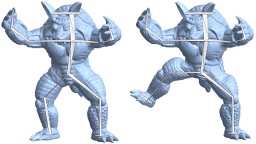 |
A Family of Barycentric Coordinates for Co-Dimension 1 Manifolds with Simplicial Facets
First Best Paper Award
Yan Z. and Schaefer S.
Computer Graphics Forum (Proceedings of the Symposium on Geometry Processing), Vol. 38, No. 5, (2019), pp. 75-83.
Abstract: We construct a family of barycentric coordinates for 2D shapes including non-convex shapes, shapes with boundaries, and skeletons. Furthermore, we extend these coordinates to 3D and arbitrary dimension. Our approach modifies the construction of the Floater-Hormann-Kos family of barycentric coordinates for 2D convex shapes. We show why such coordinates are restricted to convex shapes and show how to modify these coordinates to extend to discrete manifolds of co-dimension 1 whose boundaries are composed of simplicial facets. Our coordinates are well-defined everywhere (no poles) and easy to evaluate. While our construction is widely applicable to many domains, we show several examples related to image and mesh deformation.
|
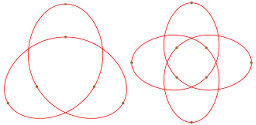 |
Circle Reproduction with Interpolatory Curves at Local Maximal Curvature Points
Yan Z., Schiller S. and Schaefer S.
Computer Aided Geometric Design, Vol. 72, (2019), pp. 98-110.
Abstract: We present a piece-wise rational, quadratic, interpolatory curve that is able to reproduce circles and other elliptical or hyperbolic shapes. The curve is curvature continuous except at infection points and points of local maximum curvature appear only at control points and nowhere else. The local maximum curvature property ensures that users have direct control over salient points of the curve, and users can control if and where features such as cusps and loops are generated. To construct the desired curve, we formulated an energy that encodes the desired properties to optimize using a boxed constrained optimization. We provide an efficient algorithm for choosing an initial guess close to the solution to accelerate convergence. In addition, we show how to automatically choose the rational weights of the curve as part of the optimization to reproduce shapes such as circles.
|
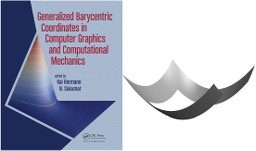 |
Multi-Sided Patches via Barycentric Coordinates
Schaefer S.
This is a pre-print version of Chapter 8 in Generalized Barycentric Coordinates in Computer Graphics and Computational Mechanics. Eds. Hormann, K. and Sukumar N. CRC Press 2017.
Abstract: In this chapter, we explore the deep connection
between barycentric coordinates and higher order parametric representations of
curves, surfaces, volumes in arbitrary dimension. In the case of curves, these curves
are known as Bezier curves, which are used in applications from font representations to controlling animations. The extension to convex surface patches, called
S-Patches, is more recent. As originally proposed, S-Patches were parametric,
multi-sided surface patches restricted to convex domains. However, these restrictions were more of a function of the limited set of generalized barycentric coordinates, namely Wachspress coordinates, available at that time. Today we have
generalized barycentric coordinate functions that do not require convexity and extend to arbitrary dimension. Hence, we will investigate S-Patches within their full
generality afforded by modern barycentric coordinates with generalized domains
and in arbitrary dimension.
|
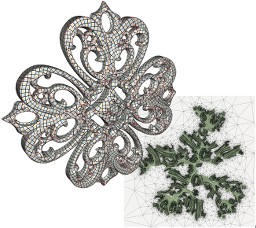 |
Simplicial Complex Augmentation Framework for Bijective Maps
Jiang, Z., Schaefer S., and Panozzo D.
ACM Transactions on Graphics (Proceedings of SIGGRAPH Asia), Vol. 36, No. 6, (2017), pp. 186:1-186:9
Abstract: Bijective maps are commonly used in many computer graphics and scientific
computing applications, including texture, displacement, and bump mapping.
However, their computation is numerically challenging due to the global nature
of the problem, which makes standard smooth optimization techniques
prohibitively expensive. We propose to use a scaffold structure to reduce
this challenging and global problem to a local injectivity condition. This
construction allows us to benefit from the recent advancements in locally
injective maps optimization to efficiently compute large scale bijective maps
(both in 2D and 3D), sidestepping the need to explicitly detect and avoid collisions.
Our algorithm is guaranteed to robustly compute a globally bijective
map, both in 2D and 3D. To demonstrate the practical applicability, we use it
to compute globally bijective single patch parametrizations, to pack multiple
charts into a single UV domain, to remove self-intersections from existing
models, and to deform 3D objects while preventing self-intersections. Our
approach is simple to implement, efficient (two orders of magnitude faster
than competing methods), and robust, as we demonstrate in a stress test on
a parametrization dataset with over a hundred meshes.
|
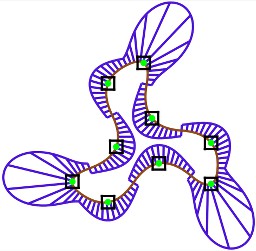 |
k-Curves: Interpolation at Local Maximum Curvature
Yan Z., Schiller S., Wilensky G., Carr N., and Schaefer S.
ACM Transactions on Graphics (Proceedings of SIGGRAPH), Vol. 36, No. 4, (2017), pp. 129:1-129:7, slides
Abstract: We present a method for constructing almost-everywhere curvature-continuous,
piecewise-quadratic curves that interpolate a list of control points and have
local maxima of curvature only at the control points. Our premise is that
salient features of the curve should occur only at control points to avoid the
creation of features unintended by the artist. While many artists prefer to
use interpolated control points, the creation of artifacts, such as loops and
cusps, away from control points has limited the use of these types of curves.
By enforcing the maximum curvature property, loops and cusps cannot be
created unless the artist intends for them to be.
To create such curves, we focus on piecewise quadratic curves, which
can have only one maximum curvature point. We provide a simple, iterative
optimization that creates quadratic curves, one per interior control point,
that meet with G2 continuity everywhere except at inflection points of the
curve where the curves are G1. Despite the nonlinear nature of curvature,
our curves only obtain local maxima of the absolute value of curvature only
at interpolated control points.
|
 |
Isometry-Aware Preconditioning for Mesh Parameterization
Third Best Paper Award
Claici S., Bessmeltsev M., Schaefer S., and Solomon J.
Computer Graphics Forum (Proceedings of the Symposium on Geometry Processing), Vol. 36, (2017), pp. 37-47
Abstract: This paper presents a new preconditioning technique for large-scale geometric optimization problems, inspired by applications
in mesh parameterization. Our positive (semi-)definite preconditioner acts on the gradients of optimization problems whose
variables are positions of the vertices of a triangle mesh in R2 or of a tetrahedral mesh in R3, converting localized distortion
gradients into the velocity of a globally near-rigid motion via a linear solve. We pose our preconditioning tool in terms of
the Killing energy of a deformation field and provide new efficient formulas for constructing Killing operators on triangle and
tetrahedral meshes. We demonstrate that our method is competitive with state-of-the-art algorithms for locally injective parameterization
using a variety of optimization objectives and show applications to two- and three-dimensional mesh deformation.
|
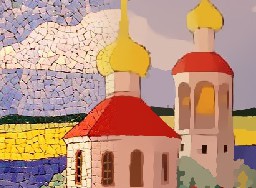 |
Image Structure Retrieval via L0 Minimization
Sun Y., Schaefer S., and Wang W.
Transactions on Visualization and Computer Graphics, Vol. 24, No. 7, (2017), pp. 2129-2139
Abstract: Retrieving salient structure from textured images is an important but difficult problem in computer vision because texture, which can be irregular, anisotropic, non-uniform and complex, shares many of the same properties as structure. Observing that salient structure in a textured image should be piece-wise smooth, we present a method to retrieve such structures using an L0 minimization of a modified form of the relative total variation metric. Thanks to the characteristics shared by texture and small structures, our method is effective at retrieving structure based on scale as well. Our method outperforms state-of-art methods in texture removal as well as scale-space filtering. We also demonstrate our method's ability in other applications such as edge detection, clip art compression artifact removal, and inverse half-toning.
|
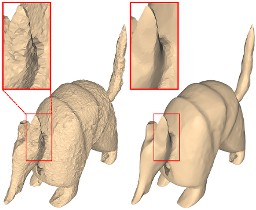 |
Robust Mesh Denoising via Vertex Pre-filtering and L1-Median Normal Filtering
Lu X., Chen W., and Schaefer S.
Computer Aided Geometric Design, Vol. 54, (2017), pp. 49-60
Abstract: We propose a robust and effective mesh denoising approach consisting of three steps: vertex pre-filtering, L1-median
normal filtering, and vertex updating. Given an input noisy mesh model, our method generates a high quality model
that preserves geometric features. Our approach is more robust than state of the art approaches when denoising models
with different levels of noise and can handle models with irregular surface sampling.
|
 |
Pyramid Algorithms for Barycentric Rational Interpolation
Hormann K. and Schaefer S.
Computer Aided Geometric Design, Vol. 42, (2016), pp. 1-6
Abstract: We present a new perspective on the Floater--Hormann interpolant. This interpolant is rational of degree (n,d), reproduces polynomials of degree d, and has no real poles. By casting the evaluation of this interpolant as a pyramid algorithm, we first demonstrate a close relation to Neville's algorithm. We then derive an O(nd) algorithm for computing the barycentric weights of the Floater-Hormann interpolant, which improves upon the original O(nd^2) construction.
|
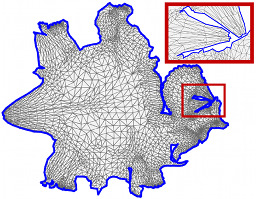 |
Bijective Parameterization with Free Boundaries
Smith J. and Schaefer S.
ACM Transactions on Graphics (Proceedings of SIGGRAPH), Vol. 34, No. 4, (2015), pp. 70:1-70:9, slides, movie, movie,movie,movie
Abstract: We present a fully automatic method for generating guaranteed bijective surface parameterizations from triangulated 3D surfaces partitioned into charts. We do so by using a distortion metric that prevents local folds of triangles in the parameterization and a barrier function that prevents intersection of the chart boundaries. In addition, we show how to modify the line search of an interior point method to directly compute the singularities of the distortion metric and barrier functions to maintain a bijective map. By using an isometric metric that is efficient to compute and a spatial hash to accelerate the evaluation and gradient of the barrier function for the boundary, we achieve fast optimization times. Unlike previous methods, we do not require the boundary be constrained by the user to a non-intersecting shape to guarantee a bijection, and the boundary of the parameterization is free to change shape during the optimization to minimize distortion.
|
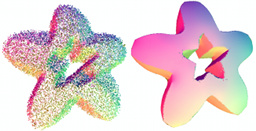 |
Denoising Point Sets via L0 Minimization
Sun Y., Schaefer S., and Wang W.
Computer Aided Geometric Design (Proceedings of GMP), Vol. 35 (2015), pp. 2-15
Abstract: We present an anisotropic point cloud denoising method using L0 minimization. The L0 norm directly measures the sparsity of a solution, and we observe that many common objects can be defined as piece-wise smooth surfaces with
a small number of features. Hence, we demonstrate how to apply an L0 optimization directly to point clouds, which
produces sparser solutions and sharper surfaces than either the L1 or L2 norms. Our method can faithfully recover
sharp features while at the same time smoothing the remaining regions even in the presence of large amounts of noise.
|
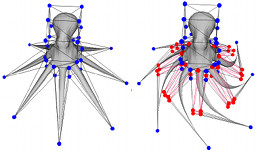 |
Selective Degree Elevation for Multi-Sided Bézier Patches
Smith J. and Schaefer S.
Computer Graphics Forum (Proceedings of Eurographics), Vol. 34, No. 2 (2015), pp.609-615
Abstract: This paper presents a method to selectively elevate the degree of an S-Patch of arbitrary dimension. We consider
not only S-Patches with 2D domains but 3D and higher-dimensional domains as well, of which volumetric cage
deformations are a subset. We show how to selectively insert control points of a higher degree patch into a lower
degree patch while maintaining the polynomial reproduction order of the original patch. This process allows the
user to elevate the degree of only one portion of the patch to add new degrees of freedom or maintain continuity
with adjacent patches without elevating the degree of the entire patch, which could create far more degrees of
freedom than necessary. Finally we show an application to cage-based deformations where we increase the number
of control points by elevating the degree of a subset of cage faces. The result is a cage deformation with higher
degree triangular Bézier functions on a subset of cage faces but no interior control points.
|
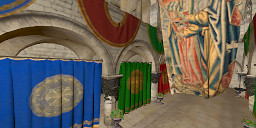 |
Bilinear Accelerated Filter Approximation
Manson J. and Schaefer S.
Computer Graphics Forum (Proceedings of EGSR), Vol. 33, No. 4 (2014), pp. 33-40, supplemental material
Abstract: Our method approximates exact texture filtering for arbitrary scales and translations of an image while taking into
account the performance characteristics of modern GPUs. Our algorithm is fast because it accesses textures with
a high degree of spatial locality. Using bilinear samples guarantees that the texels we read are in a regular pattern
and that we use a hardware accelerated path. We control the texel weights by manipulating the u, v parameters of
each sample and the blend factor between the samples. Our method is similar in quality to Cardinality-Constrained
Texture Filtering but runs two times faster.
|
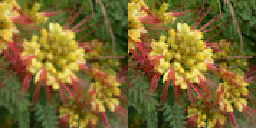 |
Cardinality-Constrained Texture Filtering
Manson J. and Schaefer S.
ACM Transactions on Graphics (Proceedings of SIGGRAPH), Vol. 32, No. 4 (2013), pp. 140:1-140:8, slides, supplemental material, code
Abstract: We present a method to create high-quality sampling filters by combining a prescribed number of texels from several resolutions in a mipmap. Our technique provides fine control over the number of texels we read per texture sample so that we can scale quality to match a memory bandwidth budget. Our method also has a fixed cost regardless of the filter we approximate, which makes it feasible to approximate higher-quality filters such as a Lanczos 2 filter in real-time rendering. To find the best set of texels to represent a given sampling filter and what weights to assign those texels, we perform a cardinality-constrained least-squares optimization of the most likely candidate solutions and encode the results of the optimization in a small table that is easily stored on the GPU. We present results that show we accurately reproduce filters using few texel reads and that both quality and speed scale smoothly with available bandwidth. When using four or more texels per sample, our image quality exceeds that of conventional trilinear interpolation.
|
 |
Mesh Denoising via L0 Minimization
He L. and Schaefer S.
ACM Transactions on Graphics (Proceedings of SIGGRAPH), Vol. 32, No. 4 (2013), pp. 64:1-64:8, slides
Abstract: We present an algorithm for denoising triangulated models based on L0 minimization. Our method maximizes the flat regions of the model and gradually removes noise while preserving sharp features. As part of this process, we build a discrete differential operator for arbitrary triangle meshes that is robust with respect to degenerate
triangulations. We compare our method versus other anisotropic denoising algorithms and demonstrate that our method is more robust and produces good results even in the presence of high noise.
|
 |
Analytic Rasterization of Curves with Polynomial Filters
Manson J. and Schaefer S.
Computer Graphics Forum (Proceedings of the Eurographics), Vol. 32, No. 2 (2013), pages 499-507, slides, supplemental material, code, code
Abstract: We present a method of analytically rasterizing shapes that have curved boundaries and linear color gradients
using piecewise polynomial prefilters. By transforming the convolution of filters with the image from an integral
over area into a boundary integral, we find closed-form expressions for rasterizing shapes. We show that a polynomial
expression can be used to rasterize any combination of polynomial curves and filters. Our rasterizer also
handles rational quadratic boundaries, which allows us to evaluate circles and ellipses. We apply our technique to
rasterizing vector graphics and show that our derivation gives an efficient implementation as a scanline rasterizer.
|
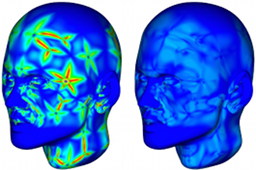 |
Improving the Parameterization of Approximate Subdivision Surfaces
He L., Loop C., and Schaefer S.
Computer Graphics Forum (Proceedings of Pacific Graphics), Vol. 31, No. 7 (2012), pages 2127-2134, slides
Abstract: We provide a method for improving the parameterization of patching schemes that approximate Catmull-Clark subdivision surfaces, such that the new parameterization conforms better to that of the original subdivision surface. We create this reparameterization in real-time using a method that only depends on the topology of the surface and is independent of the surface's geometry. Our method can handle patches with more than one extraordinary vertex and avoids the combinatorial increase in both complexity and storage associated with multiple extraordinary vertices. Moreover, the reparameterization function is easy to implement and fast.
|
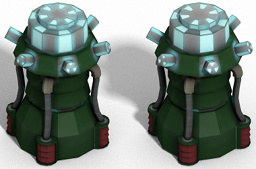 |
Parameterization-Aware MIP-Mapping
Manson J. and Schaefer S.
Computer Graphics Forum (Proceedings of the Eurographics Symposium on Rendering), Vol. 31, No. 4 (2012), pages 1455-1463, slides, errata, code
Abstract: We present a method of generating mipmaps that takes into account the distortions due to the parameterization of a surface. Existing algorithms for generating mipmaps assume that the texture is isometrically mapped to the surface and ignore the actual surface parameterization. Our method correctly downsamples warped textures by assigning texels weights proportional to their area on a surface. We also provide a least-squares approach to filtering over these warped domains that takes into account the postfilter used by the GPU. Our method improves texture filtering for most models but only modifies mipmap generation, requires no modification of art assets or rasterization algorithms, and does not affect run-time performance.
|
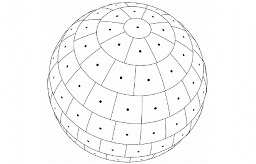 |
Encoding Normal Vectors using Optimized Spherical Coordinates
Smith J., Petrova G. and Schaefer S.
Computers & Graphics (Proceedings of Shape Modeling International), Vol. 36, No. 5 (2012), pages 360-365, slides
Abstract: We present a method for encoding unit vectors based on spherical coordinates that out-performs existing encoding
methods both in terms of accuracy and encoding/decoding time. Given a tolerance epsilon, we solve a simple, discrete
optimization problem to find a set of points on the unit sphere that can trivially be indexed such that the difference
in angle between the encoded vector and the original are no more than epsilon apart. To encode a unit vector, we simply
compute its spherical coordinates and round the result based on the prior optimization solution. We also present a
moving frame method that further reduces the amount of data to be encoded when vectors have some coherence. Our
method is extremely fast in terms of encoding and decoding both of which take constant time O(1). The accuracy of
our encoding is also comparable or better than previous methods for encoding unit vectors.
|
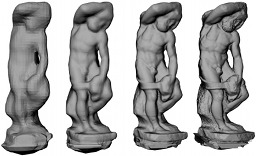 |
Progressive Encoding and Compression of Surfaces Generated from Point Cloud Data
Smith J., Petrova G. and Schaefer S.
Computers & Graphics (Proceedings of Shape Modeling International), Vol. 36, No. 5 (2012), pages 341-348, slides
Abstract: We present a new algorithm for compressing surfaces created from oriented points, sampled using a laser range
scanner or created from polygonal surfaces. We first use the input data to build an octree whose nodes contain planes
that are constructed as the least square fit of the data within that node. Then, given an error threshold, we prune this
octree to remove redundant data while avoiding topological changes created by merging disjoint linear pieces. From
this octree representation, we provide a progressive encoding technique that encodes the octree structure as well as
the plane equations. We encode the planes using distances to three points and a single bit. To decode these planes,
we solve a constrained optimization problem that has closed-form solution. We then reconstruct the surface from
this representation by implicitizing the discontinuous linear pieces at the leaves of the octree and take a level set of
this implicit representation. Our tests show that the proposed method compresses surfaces with higher accuracy and
smaller file sizes than other methods.
|
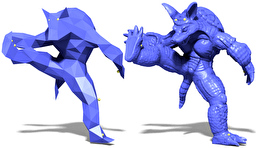 |
Hierarchical Deformation of Locally Rigid Meshes
Manson J. and Schaefer S.
Computer Graphics Forum, Vol. 30, No. 8 (2011), pages 2387-2396, slides, movie, movie
Abstract: We propose a method for calculating deformations of models by deforming a low-resolution mesh and adding details while ensuring that the details we add satisfy a set of constraints. Our method builds a low-resolution representation of a mesh by using edge collapses and performs an as-rigid-as-possible deformation on the simplified mesh. We then add back details by reversing edge-collapses so that the shape of the mesh is locally preserved. While adding details, we deform the mesh to match the predicted positions of constraints so that constraints on the full-resolution mesh are met. Our method operates on meshes with arbitrary triangulations, satisfies constraints over the full-resolution mesh, and converges quickly.
|
 |
Positive Gordon-Wixom Coordinates
Manson J., Li K. and Schaefer S.
Computer Aided Design (Proceedings of Geometric and Physical Modeling), Vol. 43, No. 11 (2011), pages 1422-1426, slides
Abstract: We introduce a new construction of transfinite barycentric coordinates for arbitrary closed sets in 2D. Our method extends weighted Gordon-Wixom interpolation to non-convex shapes and produces coordinates that are positive everywhere in the interior of the domain and that are smooth for shapes with smooth boundaries. We achieve these properties by using the distance to lines tangent to the boundary curve to define a weight function that is positive and smooth. We derive closed-form expressions for arbitrary polygons in 2D and compare the basis functions of our coordinates with several other types of barycentric coordinates.
|
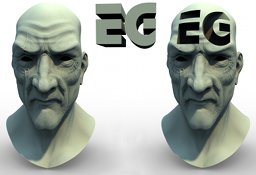 |
Wavelet Rasterization
Best Paper Award
Manson J. and Schaefer S.
Computer Graphics Forum (Proceedings of Eurographics), Vol. 30, No. 2 (2011), pages 395-404, slides, code, code
Abstract: We present a method for analytically calculating an anti-aliased rasterization of arbitrary polygons or fonts bounded by Bezier curves in 2D as well as oriented triangle meshes in 3D. Our algorithm rasterizes multiple resolutions simultaneously using a hierarchical wavelet representation and is robust to degenerate inputs. We show that using the simplest wavelet, the Haar basis, is equivalent to performing a box-filter to the rasterized image. Because we evaluate wavelet coefficients through line integrals in 2D, we are able to derive analytic solutions for polygons that have Bezier curve boundaries of any order, and we provide solutions for quadratic and cubic curves. In 3D, we compute the wavelet coefficients through analytic surface integrals over triangle meshes and show how to do so in a computationally efficient manner.
|
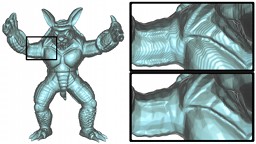 |
Contouring Discrete Indicator Functions
Manson J., Smith J. and Schaefer S.
Computer Graphics Forum (Proceedings of Eurographics), Vol. 30, No. 2 (2011), pages 385-393, slides, code
Abstract: We present a method for calculating the boundary of objects from Discrete Indicator Functions that store 2-material volume fractions with a high degree of accuracy. Although Marching Cubes and its derivatives are effective methods for calculating contours of functions sampled over discrete grids, these methods perform poorly when contouring non-smooth functions such as Discrete Indicator Functions. In particular, Marching Cubes will generate surfaces that exhibit aliasing and oscillations around the exact surface. We derive a simple solution to remove these problems by using a new function to calculate the positions of vertices along cell edges that is efficient, easy to implement, and does not require any optimization or iteration. Finally, we provide empirical evidence that the error introduced by our contouring method is significantly less than is introduced by Marching Cubes.
|
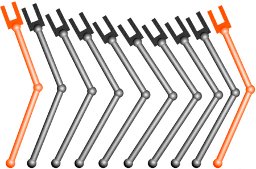 |
Parameterization and Applications of Catmull-Rom Curves
Yuksel C., Schaefer S. and Keyser J.
Computer-Aided Design, Vol. 43, No. 7 (2011), pages 747-755.
Abstract: The behavior of Catmull-Rom curves heavily depends on the choice of parameter values at the control points. We analyze a class of parameterizations ranging from uniform to chordal parameterization and show that, within this class, curves with centripetal parameterization contain properties that no other curves in this family possess. Researchers have previously indicated that centripetal parameterization produces visually favorable curves compared to uniform and chordal parameterizations. However, the mathematical reasons behind this behavior have been ambiguous. In this paper we prove that, for cubic Catmull-Rom curves, centripetal parameterization is the only parameterization in this family that guarantees that the curves do not form cusps or self-intersections within curve segments. Furthermore, we provide a formulation that bounds the distance of the curve to the control polygon and explain how globally intersection-free Catmull-Rom curves can be generated using these properties. Finally, we discuss two example applications of Catmull-Rom curves and show how the choice of parameterization makes a signicant difference in each of these applications.
|
 |
Triangle Surfaces with Discrete Equivalence Classes
Singh M. and Schaefer S.
ACM Transactions on Graphics (Proceedings of SIGGRAPH), Vol. 29, No. 4 (2010), pages 46:1 - 46:7, slides, movie, movie
Abstract: We propose a technique that takes a triangulated surface as input
and outputs a surface with the same topology but altered geometry
such that each polygon falls into a set of discrete equivalence
classes. We begin by describing an error function that measures
how close the polygons are to satisfying this criteria. To optimize
this error function, we first cluster triangles into discrete sets such
that the assignment of sets minimizes our error. We then find canonical
polygons for each set using nonlinear optimization. Next, we
solve a Poisson equation to find positions of vertices such that the
surface polygons match the canonical polygons as close as possible.
We also describe how to incorporate a fairness criteria into
the optimization to avoid oscillations of the surface. We iterate this
entire process until we reach a user specified tolerance, possibly
adding clusters during iteration to guarantee convergence. We have
been able to successfully reduce the number of unique triangles to
lie within a small percentage of the total number of triangles in the
surface and demonstrate our technique on various examples.
|
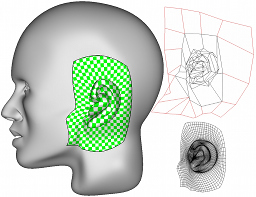 |
Parameterizing Subdivision Surfaces
He L., Schaefer S. and Hormann K.
ACM Transactions on Graphics (Proceedings of SIGGRAPH), Vol. 29, No. 4 (2010), pages 120:1 - 120:6, slides
Abstract: We present a method for parameterizing subdivision surfaces in an as-rigid-as-possible fashion. While much work has concentrated on parameterizing polygon meshes, little if any work has focused on subdivision surfaces despite their popularity. We show that polygon parameterization methods produce suboptimal results when applied to subdivision surfaces and describe how these methods may be modified to operate on subdivision surfaces. We also describe a method for creating extended charts to further reduce the distortion of the parameterization. Finally we demonstrate how to take advantage of the multi-resolution structure of subdivision surfaces to accelerate convergence of our optimization.
|
 |
Scales and Scale-Like Structures
Landreneau E. and Schaefer S.
Computer Graphics Forum (Proceedings of the Symposium on Geometry Processing), Vol. 29, No. 5 (2010), pages 1653-1660, slides, movie, additional examples
Abstract: We present a method for generating scales and scale-like structures on a polygonal mesh through surface replacement.
As input, we require a triangular mesh that will be covered with scales and one or more proxy-models to
be used as the scale’s shape. A user begins scale generation by drawing a lateral line on the model to control
the distribution and orientation of scales on the surface. We then create a vector field over the surface to control
an anisotropic Voronoi tessellation, which represents the region occupied by each scale. Next we replace these
regions by cutting the proxy model to match the boundary of the Voronoi region and deform the cut model onto
the surface. The result is a fully connected 2-manifold that is suitable for subsequent post-processing applications
like surface subdivision.
|
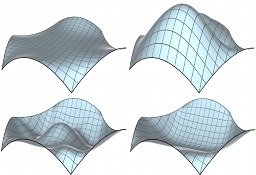 |
Moving Least Squares Coordinates
Manson J. and Schaefer S.
Computer Graphics Forum (Proceedings of the Symposium on Geometry Processing), Vol. 29, No. 5 (2010), pages 1517-1524, slides
Abstract: We propose a new family of barycentric coordinates that have closed-forms for arbitrary 2D polygons. These
coordinates are easy to compute and have linear precision even for open polygons. Not only do these coordinates
have linear precision, but we can create coordinates that reproduce polynomials of a set degree m as long as degree
m polynomials are specified along the boundary of the polygon. We also show how to extend these coordinates to
interpolate derivatives specified on the boundary.
|
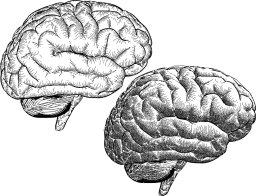 |
Suggestive Hatching
Singh M. and Schaefer S.
Computational Aesthetics 2010, pages 25-32, slides
Abstract: We present a method for drawing lines on an object that depict both the shape and shading of the object. To do so, we construct a gradient field of the diffuse intensity of the surface to guide a set of adaptively spaced lines. The shape of these lines reflect the lighting under which the object is being viewed and its shape. When the light source is placed at the viewer’s location, these lines emanate from silhouettes and naturally extend Suggestive Contours. By using a hierarchical proximity grid, we can also improve the quality of these lines as well as control their density over the image. We also provide a method for detecting and removing ridge lines in the intensity field, which lead to artifacts in the line drawings.
|
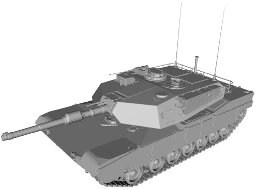 |
Isosurfaces Over Simplicial Partitions of Multiresolution Grids
Manson J. and Schaefer S.
Computer Graphics Forum (Proceedings of Eurographics), Vol. 29, No. 2 (2010), pages 377-385, slides, code
Abstract: We provide a simple method that extracts an isosurface that is manifold and intersection-free from a function over
an arbitrary octree. Our method samples the function dual to minimal edges, faces, and cells, and we show how
to position those samples to reconstruct sharp and thin features of the surface. Moreover, we describe an error
metric designed to guide octree expansion such that flat regions of the function are tiled with fewer polygons than
curved regions to create an adaptive polygonalization of the isosurface. We then show how to improve the quality
of the triangulation by moving dual vertices to the isosurface and provide a topological test that guarantees
we maintain the topology of the surface. While we describe our algorithm in terms of extracting surfaces from
volumetric functions, we also show that our algorithm extends to generating manifold level sets of co-dimension
1 of functions of arbitrary dimension.
|
 |
Approximating Subdivision Surfaces with Gregory Patches for Hardware Tessellation
Loop C., Schaefer S., Ni T. and Castano I.
ACM Transactions on Graphics (Proceedings of SIGGRAPH Asia), Vol. 28, No. 5 (2009), pages 151:1 - 151:9, slides, movie
Abstract: We present a new method for approximating subdivision surfaces with hardware accelerated parametric patches. Our method improves the memory requirements for patch control points, translating into superior performance compared to existing methods. Our input is general, allowing for meshes that contain both quadrilateral and triangular faces in the input control mesh, as well as control meshes with boundary. We present two implementations of our scheme designed to run on Direct3D 11 class hardware equipped with a tessellator unit.
|
 |
Hair Meshes
Yuksel C., Schaefer S. and Keyser J.
ACM Transactions on Graphics (Proceedings of SIGGRAPH Asia), Vol. 28, No. 5 (2009), pages 166:1 - 166:7, slides, movie, proceedings title page image
Abstract: Despite the visual importance of hair and the attention paid to hair modeling in the graphics research, modeling realistic hair
still remains a very challenging task that can be performed by very
few artists. In this paper we present hair meshes, a new
method for modeling hair that aims to bring hair modeling as close
as possible to modeling polygonal surfaces. This new approach
provides an artist with direct control of the overall shape of the
hair, giving them the ability to model the exact hair shape they
desire. We use the hair mesh structure for modeling the hair volume
with topological constraints that allow us to automatically and
uniquely trace the path of individual hair strands through this
volume. We also define a set of topological operations for creating
hair meshes that maintain these constraints. Furthermore, we provide
a method for hiding the volumetric structure of the hair mesh from
the end user, thus allowing artists to concentrate on manipulating
the outer surface of the hair as a polygonal surface. We explain and show examples of how hair meshes can be used to generate individual hair strands for a wide variety of realistic hair styles.
|
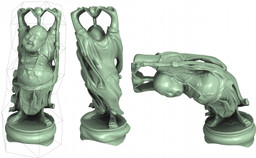 |
Poisson-based Weight Reduction of Animated Meshes
Landreneau E. and Schaefer S.
Computer Graphics Forum, Vol. 29, No. 6 (2010), pages 1945-1954, movie
Abstract: While animation using barycentric coordinates or other automatic weight assignment methods has become a
popular method for shape deformation, the global nature of the weights limits their use for real-time applications.
We present a method that reduces the number of control points influencing a vertex to a user-specified number such
that the deformations created by the reduced weight set resemble that of the original deformation. To do so we
show how to set up a Poisson minimization problem to solve for a reduced weight set and illustrate its advantages
over other weight reduction methods. Not only does weight reduction lower the amount of storage space necessary
to deform these models but also allows GPU acceleration of the resulting deformations. Our experiments show
that we can achieve a factor of 100 increase in speed over CPU deformations using the full weight set, which
makes real-time deformations of large models possible.
|
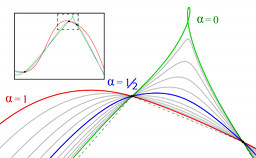 |
On the Parameterization of Catmull-Rom Curves
Yuksel C., Schaefer S. and Keyser J.
SIAM/ACM Joint Conference on Geometric and Physical Modeling 2009, pages 47-53, slides
Abstract: The behavior of Catmull-Rom curves heavily depends on the
choice of parameter values at the control points. We analyze a class of parameterizations ranging from uniform to
chordal parameterization and show that, within this class,
curves with centripetal parameterization contain properties
that no other curves in this family possess. Researchers
have previously indicated that centripetal parameterization
produces visually favorable curves compared to uniform and
chordal parameterizations. However, the mathematical reasons behind this behavior have been ambiguous. In this paper we prove that, for cubic Catmull-Rom curves, centripetal
parameterization is the only parameterization in this family that guarantees that the curves do not form cusps or
self-intersections within curve segments. Furthermore, we
provide a formulation that bounds the distance of the curve
to the control polygon and explain how globally intersection free Catmull-Rom curves can be generated using these properties.
|
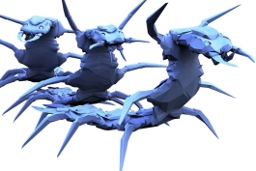 |
Simplification of Articulated Meshes
Landreneau E. and Schaefer S.
Computer Graphics Forum (Proceedings of Eurographics), Vol. 28, No. 2 (2009), pages 347-353, slides, movie
Abstract: We present a method for simplifying a polygonal character with an associated
skeletal deformation such that the simplified character approximates the original
shape well when deformed. As input, we require a set of example poses that are
representative of the types of deformations the character undergoes and we produce a
multi-resolution hierarchy for the simplified character where all simplified vertices
also have associated skin weights. We create this hierarchy by minimizing an error
metric for a simplified set of vertices and their skin weights, and we show that this
quartic error metric can be effectively minimized using alternating quadratic
minimization for the vertices and weights separately. To enable efficient GPU
accelerated deformations of the simplified character, we also provide a method that
guarantees the maximum number of bone weights per simplified vertex is less than a
user specified threshold at all levels of the hierarchy.
|
 |
Non-uniform Subdivision for B-splines of Arbitrary Degree
Schaefer S. and Goldman R.
Computer Aided Geometric Design, Vol. 26, No. 1 (2009), pages 75-81, slides, slides
Abstract: We present an efficient algorithm for subdividing non-uniform B-splines of arbitrary
degree in a manner similar to the Lane-Riesenfeld subdivision algorithm for uniform Bsplines
of arbitrary degree. Our algorithm consists of doubling the control points followed
by d rounds of non-uniform averaging similar to the d rounds of uniform averaging in the
Lane-Riesenfeld algorithm for uniform B-splines of degree d. However, unlike the Lane-
Riesenfeld algorithm which follows most directly from the continuous convolution formula
for the uniform B-spline basis functions, our algorithm follows naturally from blossoming.
We show that our knot insertion method is simpler and more efficient than previous knot
insertion algorithms for non-uniform B-splines.
|
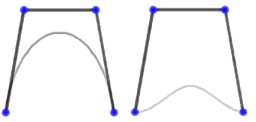 |
On the Smoothness of Real-Valued Functions Generated by
Subdivision Schemes Using Nonlinear Binary Averaging
Goldman R., Vouga E. and Schaefer S.
Computer Aided Geometric Design, Vol. 26, No. 2 (2009), pages 231-242
Abstract: Our main result is that two point interpolatory subdivision schemes using C^k nonlinear averaging
rules on pairs of real numbers generate real-valued functions that are also C^k. The significance of this
result is the following consequence: Suppose that S is a subdivision algorithm operating on sequences
of real numbers using linear binary averaging that generates C^m real-valued functions and Sbar is the
same subdivision procedure where linear binary averaging is replaced everywhere in the algorithm by
a C^n nonlinear binary averaging rule on pairs of real numbers; then the functions generated by the
nonlinear subdivision scheme Sbar are C^k , where k = min(m, n).
|
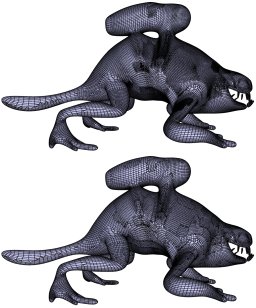 |
Exact Evaluation of Limits and Tangents for Non-Polynomial Subdivision Schemes
Schaefer S. and Warren J.
Computer Aided Geometric Design, Vol. 25, No. 8 (2008), pages 607-620
Abstract: In this paper, we describe a method for exact evaluation of a limit mesh defined via
subdivision and its associated tangent vectors on a uniform grid of any size. Other
exact evaluation techniques either restrict the grids to have subdivision sampling and
are, hence, exponentially increasing in size or make assumptions about the underlying
surface being piecewise polynomial (Stam’s method is a widely used technique
that makes this assumption). As opposed to Stam’s technique, our method works
for both polynomial and non-polynomial schemes. The values for this exact evaluation
scheme can be computed via a simple system of linear equation derived from
the scaling relations associated with the scheme or, equivalently, as the dominant
left eigenvector of an upsampled subdivision matrix associated with the scheme. To
illustrate one possible application of this method, we demonstrate how to generate
adaptive polygonalizations of a non-polynomial quad-based subdivision surfaces using
our exact evaluation method. Our tessellation method guarantees a water-tight
tessellation no matter how the surface is sampled and is quite fast. We achieve tessellation
rates of over 33.5 million triangles/second using a CPU implementation.
|
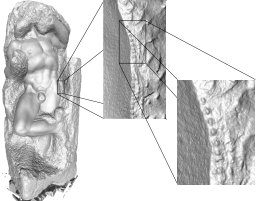 |
Streaming Surface Reconstruction Using Wavelets
Manson J., Petrova G. and Schaefer S.
Computer Graphics Forum (Proceedings of the Symposium on Geometry Processing), Vol. 27, No. 5 (2008), pages 1411-1420, slides, project page, cover image
Abstract: We present a streaming method for reconstructing surfaces from large data sets generated by a laser range scanner
using wavelets. Wavelets provide a localized, multiresolution representation of functions and this makes them ideal
candidates for streaming surface reconstruction algorithms. We show how wavelets can be used to reconstruct the
indicator function of a shape from a cloud of points with associated normals. Our method proceeds in several
steps. We first compute a low-resolution approximation of the indicator function using an octree followed by
a second pass that incrementally adds fine resolution details. The indicator function is then smoothed using a
modified octree convolution step and contoured to produce the final surface. Due to the local, multiresolution
nature of wavelets, our approach results in an algorithm over 10 times faster than previous methods and can
process extremely large data sets in the order of several hundred million points in only an hour.
|
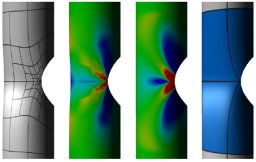 |
G^2 Tensor Product Splines over Extraordinary Vertices
Loop C. and Schaefer S.
Computer Graphics Forum (Proceedings of the Symposium on Geometry Processing), Vol. 27, No. 5 (2008), pages 1373-1382, slides, cover image
Abstract: We present a second order smooth filling of an n-valent Catmull-Clark spline ring with n biseptic patches. While
an underdetermined biseptic solution to this problem has appeared previously, we make several advances in this
paper. Most notably, we cast the problem as a constrained minimization and introduce a novel quadratic energy
functional whose absolute minimum of zero is achieved for bicubic polynomials. This means that for the regular
4-valent case, we reproduce the bicubic B-splines. In other cases, the resulting surfaces are aesthetically well
behaved. We extend our constrained minimization framework to handle the case of input mesh with boundary.
|
 |
Approximating Catmull-Clark Subdivision Surfaces with Bicubic Patches
Loop C. and Schaefer S.
ACM Transactions on Graphics, Vol 27, No. 1 (2008), pages 8:1-8:11, slides, movie
Abstract: We present a simple and computationally efficient algorithm for
approximating Catmull-Clark subdivision surfaces using a minimal
set of bicubic patches. For each quadrilateral face of the
control mesh, we construct a geometry patch and a pair of tangent
patches. The geometry patches approximate the shape and
silhouette of the Catmull-Clark surface and are smooth everywhere
except along patch edges containing an extraordinary vertex where
the patches are C^0. To make the patch surface appear smooth,
we provide a pair of tangent patches that approximate the tangent
fields of the Catmull-Clark surface. These tangent patches are
used to construct a continuous normal field (through their
cross-product) for shading and displacement mapping. Using this
bifurcated representation, we are able to define an accurate
proxy for Catmull-Clark surfaces that is efficient to evaluate on
next-generation GPU architectures that expose a programmable
tessellation unit.
|
 |
J-splines
Rossignac J. and Schaefer S.
Computer Aided Design, Vol 40, No. 10-11 (2008), pages 1024-1032
Abstract: Both the 4-point and the uniform cubic B-spline subdivisions double the number of vertices of a closed-loop polygon P^k and produce sequences of vertices f_j and b_j respectively. We study the J-spline subdivision scheme J_s, introduced by Maillot and Stam, which blends these two methods to produce vertices of the form v_j=(1–s)f_j + s b_j. Iterative applications of J_s yield a family of limit curves, the shape of which is parameterized by s. They include four-point subdivision curves (J_0), uniform cubic B-spline curves (J_1), and uniform quintic B-spline curves (J_1.5). We show that the limit curve is at least C^1 when –1.7<=s<=5.8, C^2 when 0<s<4, C^3 when 1<s<=2.8, and C^4 when s=3/2, even though 4-point yields only C^1 curves and cubic B-spline yields only C^2 curves. We generalize the J_s scheme to a two-parameter family J_{a,b} and propose data-dependent and data-independent solutions for computing values of parameters a and b that minimize various objective functions (distance to the control vertices, deviation from the control polygon, change in surface area, and popping when switching levels of subdivision in multi-resolution rendering). We extend the J-spline subdivision to open curves and to a smooth surface subdivision scheme for quad-meshes with arbitrary connectivity.
|
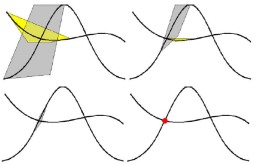 |
Nonlinear Subdivision Through Nonlinear Averaging
Schaefer S., Vouga E. and Goldman R.
Computer Aided Geometric Design, Vol. 25, No. 3 (2008), pages 162-180, slides
Abstract: We investigate a general class of nonlinear subdivision algorithms for functions of a real
or complex variable built from linear subdivision algorithms by replacing binary linear
averages such as the arithmetic mean by binary nonlinear averages such as the geometric mean. Using our method, we can easily create stationary subdivision schemes for
Gaussian functions, spiral curves, and circles with uniform parametrizations. More generally, we show that stationary subdivision schemes for e^p(x), cos(p(x)) and sin(p(x)) for
any polynomial or piecewise polynomial p(x) can be generated using only addition, subtraction, multiplication, and square roots. The smoothness of our nonlinear subdivision
schemes is inherited from the smoothness of the original linear subdivision schemes and
the differentiability of the corresponding nonlinear averaging rules. While our results are
quite general, our proofs are elementary, based mainly on the observation that generic
nonlinear averaging rules on a pair of real or complex numbers can be constructed by
conjugating linear averaging rules with locally invertible nonlinear maps. In a forthcoming paper we show that every continuous nonlinear averaging rule on a pair of real or
complex numbers can be constructed by conjugating a linear averaging rule with an associated continuous locally invertible nonlinear map. Thus the averaging rules considered
in this paper are actually the general case. As an application we show how to apply our
nonlinear subdivision algorithms to intersect some common transcendental functions.
|
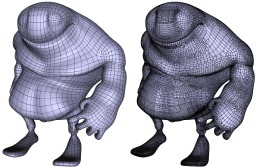 |
Exact Evaluation of Non-Polynomial Subdivision Schemes at Rational Parameter Values
Schaefer S. and Warren J.
Pacific Graphics 2007, pages 321-330, slides, movie, cover image
Abstract: In this paper, we describe a method for exact evaluation of a
limit mesh defined via subdivision on a uniform grid of any size.
Other exact evaluation technique either restrict the grids to have
subdivision sampling and are, hence, exponentially increasing in
size or make assumptions about the underlying surface being
piecewise polynomial (Stam's method is a widely used technique
that makes this assumption). As opposed to Stam's technique, our
method works for both polynomial and non-polynomial schemes. The
values for this exact evaluation scheme can be computed via a
simple system of linear equation derived from the scaling
relations associated with the scheme or, equivalently, as the
dominant left eigenvector of an upsampled subdivision matrix
associated with the scheme. To illustrate one possible
application of this method, we demonstrate how to generate
adaptive polygonalizations of a non-polynomial quad-based
subdivision surfaces using our exact evaluation method. Our
method guarantees a water-tight tessellation no matter how the
surface is sampled and is quite fast. We achieve tessellation
rates of over 33.5 million triangles/second using a CPU
implementation.
|
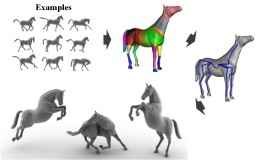 |
Example-Based Skeleton Extraction
Schaefer S. and Yuksel C.
Eurographics Symposium on Geometry Processing 2007, pages 153-162, slides, movie, cover image
Abstract: We present a method for extracting a hierarchical, rigid skeleton from a set of example poses.
We then use this skeleton to not only reproduce the example poses, but create new deformations in the same style as the examples. Since rigid skeletons are used by most 3D modeling software, this skeleton and the corresponding vertex weights can be inserted directly into existing production pipelines.
To create the skeleton, we first estimate the rigid transformations of the bones using a fast,
face clustering approach. We present an efficient method for clustering by providing a Rigid
Error Function that finds the best rigid transformation from a set of points in a robust, space efficient manner and supports fast clustering operations. Next, we solve for the vertex weights and enforce locality in the resulting weight distributions. Finally, we use these weights to determine the
connectivity and joint locations of the skeleton.
|
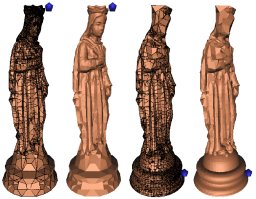 |
Manifold Dual Contouring
Schaefer S., Ju T. and Warren J.
Transactions on Visualization and Computer Graphics, Vol 13, No. 3 (2007), pages 610-619, slides
Abstract: Dual Contouring is a feature-preserving iso-surfacing
method that extracts crack-free surfaces from both uniform and
adaptive octree grids. We present an extension of Dual Contouring
that further guarantees that the mesh generated is a manifold
even under adaptive simplification. Our main contribution is
an octree-based, topology-preserving vertex clustering algorithm
for adaptive contouring. The contoured surface generated by
our method contains only manifold vertices and edges, preserves
sharp features, and possesses much better adaptivity than those
generated by other iso-surfacing methods under topologically safe
simplification.
|
 |
A Unified, Integral Construction For Coordinates Over Closed Curves
Schaefer S., Ju T. and Warren J.
Computer-Aided Geometric Design, Vol 24, No. 8-9 (2007), pages 481-493 slides
Abstract: We propose a simple generalization of Shephard's interpolation to piecewise smooth,
convex closed curves that yields a family of boundary interpolants with linear
precision. Two instances of this family reduce to previously known interpolants: one
based on a generalization of Wachspress coordinates to smooth curves and the other
an integral version of mean value coordinates for smooth curves. A third instance of
this family yields a previously unknown generalization of discrete harmonic
coordinates to smooth curves. For closed, piecewise linear curves, we prove that our
interpolant reproduces a general family of barycentric coordinates considered by
Floater, Hormann and Kos that includes Wachspress coordinates, mean value
coordinates and discrete harmonic coordinates.
|
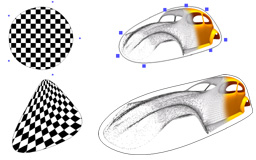 |
Barycentric Coordinates for Convex Sets
Warren J., Schaefer S., Hirani A. and Desbrun M.
Advances in Computational Mathematics, Vol 27, No. 3 (2007), pages 319-338
Abstract: In this paper we provide an extension of barycentric coordinates from
simplices to arbitrary convex sets. Barycentric coordinates over convex 2D
polygons have found numerous applications in various fields as they allow
smooth interpolation of data located on vertices. However, no explicit formulation
valid for arbitrary convex polytopes has been proposed to extend
this interpolation in higher dimensions. Moreover, there has been no attempt
to extend these functions into the continuous domain, where barycentric coordinates
are related to Green’s functions and construct functions that satisfy
a boundary value problem.
First, we review the properties and construction of barycentric coordinates
in discrete domain for convex polytopes. Next, we show how these
concepts extend into the continuous domain to yield barycentric coordinates
for continuous functions. We then provide a proof that our functions satisfy
all the desirable properties of barycentric coordinates in arbitrary dimensions.
Finally, we provide an example of constructing such barycentric functions
over regions bounded by parametric curves and show how they can be used
to perform freeform deformations.
|
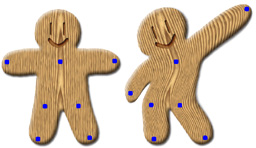 |
Image Deformation Using Moving Least Squares
Schaefer S., McPhail T. and Warren J.
ACM SIGGRAPH 2006, pages 533-540, slides
Abstract: We provide an image deformation method based on Moving Least Squares using various
classes of linear functions including affine, similarity and rigid transformations.
These deformations are realistic and give the user the impression of manipulating
real-world objects. We also allow the user to specify the deformations using either
sets of points or line segments, the later useful for controlling curves and
profiles present in the image. For each of these techniques, we provide simple
closed-form solutions that yield fast deformations, which can be performed in
real-time.
|
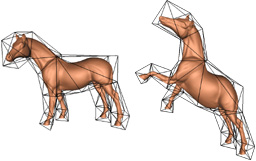 |
Mean Value Coordinates for Closed Triangular Meshes
Ju T., Schaefer S. and Warren J.
ACM SIGGRAPH 2005, pages 561-566, slides
Abstract: Constructing a function that interpolates a set of values
defined at vertices of a mesh is a fundamental operation in computer
graphics. Such an interpolant has many uses in applications such
as shading, parameterization and deformation. For closed polygons,
mean value coordinates have been proven to be an excellent method
for constructing such an interpolant. In this paper, we generalize
mean value coordinates from closed 2D polygons to closed
triangular meshes. Given such a mesh P, we show that these
coordinates are continuous everywhere and smooth on the interior
of P. The coordinates are linear on the triangles of P and can
reproduce linear functions on the interior of P. To illustrate
their usefulness, we conclude by considering several interesting
applications including constructing volumetric textures and
surface deformation.
|
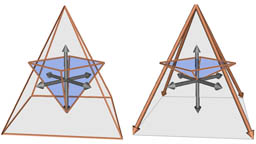 |
A Geometric Construction of Coordinates for Convex Polyhedra using Polar Duals
Ju T., Schaefer S., Warren J., Desbrun M.
Eurographics Symposium on Geometry Processing 2005, pages 181-186, slides
Abstract: A fundamental problem in geometry processing is that of expressing
a point inside a convex polyhedron as a combination of the
vertices of the polyhedron. Instances of this problem arise often
in mesh parameterization and 3D deformation. A related problem
is to express a vector lying in a convex cone as a non-negative
combination of edge rays of this cone. This problem also arises in
many applications such as planar graph embedding and spherical
parameterization. In this paper, we present a unified
geometric construction for building these weighted combinations
using the notion of polar duals. We show that our method yields a
simple geometric construction for Wachspress's barycentric
coordinates, as well as for constructing Colin de Verdiere
matrices from convex polyhedra---a critical step in Lovasz's
method with applications to parameterizations.
|
 |
Subdivision Schemes and Attractors
Schaefer S., Levin D., Goldman R.
Eurographics Symposium on Geometry Processing 2005, pages 171-180, slides
Abstract: Subdivision schemes generate self-similar curves and surfaces. Therefore
there is a close connection between curves and surfaces generated by
subdivision algorithms and self-similar fractals generated by Iterated
Function Systems (IFS). We demonstrate that this connection between
subdivision schemes and fractals is even deeper by showing that curves and
surfaces generated by subdivision are also attractors, fixed points of IFS's.
To illustrate this fractal nature of subdivision, we derive the associated IFS
for many different subdivision curves and surfaces, including B-splines,
piecewise Bezier, stationary four-point subdivision, Box-splines, Loop
subdivision and Kobbelt's sqrt(3)-subdivision surfaces. Conversely, we
shall show how to build subdivision schemes to generate traditional fractals
such as the Sierpinski gasket and the Koch curve, and we demonstrate as well
how to control the shape of these fractals by adjusting their control points.
|
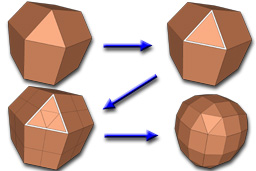 |
On C^2 Triangle/Quad Subdivision
Schaefer S. and Warren J.
ACM Transactions on Graphics, Vol 24, No. 1 (2005), pages 28-36, slides
Abstract: In this paper we present a subdivision scheme for mixed triangle/quad meshes that is C^2 everywhere except for isolated, extraordinary points where the surface is C^1. The rules that we describe are the same as Stam/Loop's scheme except that we perform an unzippering pass prior to subdivision. This simple modification improves the smoothness along the ordinary triangle/quad boundary from C^1 to C^2 and creates a scheme capable of subdividing arbitrary meshes. Finally, we end with a proof based on Levin/Levin's joint spectral radius calculation to show our scheme is indeed C^2 along the triangle/quad boundary.
|
 |
Freeform Curves on Spheres of Arbitrary Dimension
Schaefer S. and Goldman R.
Proceedings of Pacific Graphics 2005, pages 160-162, Longer Version
Abstract: Recursive evaluation procedures based on spherical linear interpolation and stationary subdivision algorithms based on geodesic midpoint averaging are used to construct the analogues on spheres of arbitrary dimension of Lagrange and Hermite interpolation and Bezier and B-spline approximation.
|
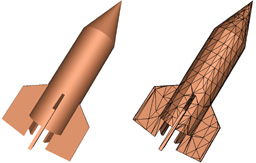 |
Dual Marching Cubes: Primal Contouring of Dual Grids
Schaefer S. and Warren J.
Proceedings of Pacific Graphics 2004, pages 70-76, slides
Abstract: We present a method for contouring an implicit function
using a grid topologically dual to structured grids such as octrees.
By aligning the vertices of the dual grid with the features of the
implicit function, we are able to reproduce thin features without
excessive subdivision required by methods such as Marching Cubes or
Dual Contouring. Dual Marching Cubes produces a crack-free,
adaptive polygonalization of the surface that reproduces sharp
features. Our approach maintains the advantage of using structured
grids for operations such as CSG while being able to conform to the
relevant features of the implicit function yielding much sparser
polygonalizations than has been possible using structured grids.
|
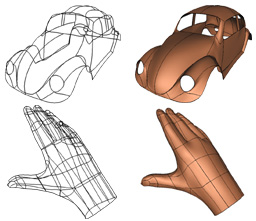 |
Lofting Curve Networks using Subdivision Surfaces
Schaefer S., Warren J. and Zorin D.
Eurographics Symposium on Geometry Processing 2004, pages 105-116, slides
Abstract: Lofting is a traditional technique for creating a curved shape by
first specifying a network of curves that approximates the desired
shape and then interpolating these curves with a smooth surface.
This paper addresses the problem of lofting from the viewpoint of
subdivision. In particular, we develop two new subdivision
schemes; a univariate scheme that converges to a network of cubic
splines and a modified Catmull-Clark scheme that lofts these curve
networks. Near the curve network, these lofted subdivision
surfaces are C^2 except for those points where three or more
curves meet at which the surface is C^1 with bounded curvature.
As a demonstration of these two methods, we have constructed an
automatic system that quadrangulates these curve networks using a
novel method and fairs the surfaces produced by our subdivision
scheme.
|
 |
Smooth Subdivision of Tetrahedral Meshes
Schaefer S., Hakenberg J. and Warren J.
Eurographics Symposium on Geometry Processing 2004, pages 151-158, slides, cover image
Abstract: We describe a new subdivision scheme for unstructured tetrahedral meshes.
Previous tetrahderal schemes based on generalizations of box splines
have encoded arbitrary directional preferences in their associated subdivision rules
that were not reflected in tetrahderal base mesh. Our method avoids this
choice of preferred directions resulting a scheme that is simple to implement
via repeated smoothing. In an extended appendix, we analyze this tetrahedral scheme
and prove that the scheme generates C^2 deformations everywhere except along edges
of the tetrahedral base mesh. Along edges shared by four or more tetrahedra in the
base mesh, we present strong evidence that the scheme generates C^1 deformations.
|
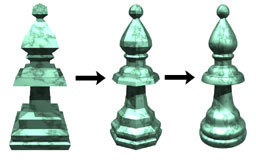 |
A Factored Approach to Subdivision Surfaces
Warren J. and Schaefer S.
Computer Graphics & Applications, Vol. 24, No. 3 (2004), pages 74-81
Abstract: This tutorial explains how to implement several different
subdivision schemes under a single, unified framework. Our
discussion will illustrate Catmull-Clark
subdivision for quadrilateral meshes, Loop
subdivision for triangular meshes, and a newer
combined subdivision scheme called Quad/Triangle
subdivision that allows the inclusion of meshes
with both quadrilateral and triangular faces. The algorithms
that we explain do not require complicated data-structures or mesh
traversal algorithms. Instead we focus on methods that illustrate
the simplicity of the implementation. Finally, we end with a
discussion on generating surfaces that are not smooth everywhere,
but instead contain sharp crease curves.
|
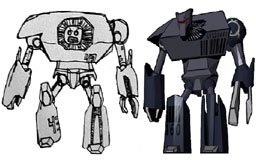 |
Teaching Computer Game Design and Construction
Schaefer S. and Warren J.
Computer-Aided Design 2004, Vol. 36(14), pages 1501-1510
Abstract: Computer gaming is a key component of the rapidly growing
entertainment industry. While building computer games has
typically been a commercial endeavor, we believe that designing
and constructing a computer game is also a useful activity for
educating students about geometric modeling and computer
graphics. In particular, students are exposed to the practical
issues surrounding topics such as geometric modeling, rendering,
collision detection, character animation and graphical design.
Moreover, building an advanced game provides students exposure to
the real-world side of software engineering that they are
typically shielded from in the standard computer class. In this
paper, we describe our experiences with teaching a computer
science class that focuses on designing and building the best game
possible in the course of a semester. The paper breaks down a
typical game into various components that are suited for
individual student projects and discusses the use of modern
graphical design tools such as Maya in building art for the
game. We conclude with a rough timeline for developing a game
during the course of a semester and review some of the lessons
learned during the three years we have taught the class.
|
 |
Turtle Geometry in Computer Graphics and Computer Aided Design
Goldman R., Schaefer S. and Ju T.
Computer-Aided Design 2004, Vol. 36(14), pages 1471-1482
Abstract: LOGO is a programming language incorporating turtle graphics, originally devised for teaching computing to young children in elementary and middle schools. Here we advocate the use of LOGO to help introduce some of the basic concepts of computer graphics and computer aided design to undergraduate and graduate students in colleges and universities. We shall show how to motivate affine coordinates and affine transofmrations, fractal curves and iterated function systems, relaxation methods and subdivision scheme from elementary notions in turtle geometry and turtle programming.
|
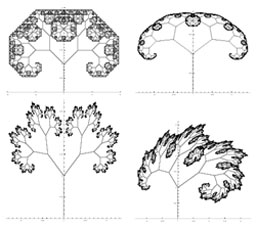 |
Recursive Turtle Programs and Iterated Affine Transformations
Ju T., Schaefer S. and Goldman R.
Computers and Graphics 2004, Vol. 28(6), pages 991-1004
Abstract: We provide a formal proof of equivalence between the class of fractals created by Recursive Turtle Programs (FTP) and Iterated Affine Transformations (IAT). We begin by reviewing RTP (a geometric interpretation of non-bracketed L-systems with a single production rule) and IAT (Iterated Function Systems restricted to affine transformations). Next, we provide a simple extension to RTP that generatlizes RTP from conformal transformations to arbitrary affine transformations. We then present constructive proofs of equivalence between the fractal geometry generated by RTP and IAT that yield conversion algorithms between these two methods. We conclude with possible extensions and a few open questions for future research.
|
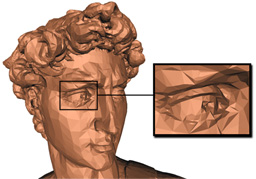 |
Adaptive Vertex Clustering Using Octrees
Schaefer S. and Warren J.
Proceedings of SIAM Geometric Design and Computing 2003, pages 491-500, slides
Abstract: We present an adaptive vertex clustering approach to out-of-core
simplification of polygonal meshes using a dynamic octree. Similar to uniform
clustering, our technique utilizes quadratic error functions to position the mesh
vertices; however, this new method can resolve vertices to arbitrary resolutions,
which allows reproduction of extremely small details and more accurate
simplifications. By sorting the vertices of the input mesh, our algorithm
dynamically discovers portions of the mesh that are locally complete, which are
then available for collapse when the octree grows too large. This adaptive octree
is then used to cluster the vertices of the input to generate a simplified mesh.
Finally, we show that our method generates the same tree that would be constructed
with unbounded memory if our method is given a small amount of space in addition
to the size of the output tree.
|
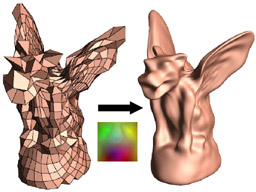 |
Smooth Geometry Images
Losasso F., Hoppe H., Schaefer S. and Warren J.
Eurographics Symposium on Geometry Processing 2003, pages 138-145, slides
Abstract: Previous parametric representations of smooth genus-zero surfaces require a collection of abutting patches (e.g.
splines, NURBS, recursively subdivided polygons). We introduce a simple construction for these surfaces using a
single uniform bi-cubic B-spline. Due to its tensor-product structure, the spline control points are conveniently
stored as a geometry image with simple boundary symmetries. The bicubic surface is evaluated using subdivision,
and the regular structure of the geometry image makes this computation ideally suited for graphics hardware.
Specifically, we let the fragment shader pipeline perform subdivision by applying a sequence of masks
(splitting, averaging, limit, and tangent) uniformly to the geometry image. We then extend this scheme to provide
smooth level-of-detail transitions from a subsampled base octahedron all the way to a finely subdivided, smooth
model. Finally, we show how the framework easily supports scalar displacement mapping.
|
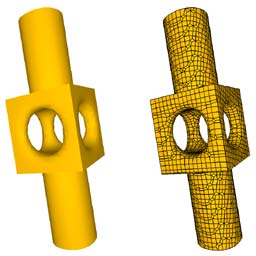 |
Dual Contouring: "The Secret Sauce"
Schaefer S. and Warren J.
Technical Report TR 02-408
Abstract: This paper provides several contributions related to dual contouring implicit data including
solving rank deficient QEF's, reducing memory requirements, and performing fast polygon updates
during CSG. First, we describe our method for solving QEF's and provide a method using mass points
that improves vertex placement in the rank deficient case. This improvement leads to a technique
for handling vertex placement in the presence of non-manifold sign configurations. Next, we
provide a method for reducing the space requirements for storing the implicit data needed to
generate the contour. Finally, we describe our method for storing the geometry data in a format
suitable for fast display on modern graphics hardware as well as techniques for updating the data-structure
in constant time during CSG operations.
|
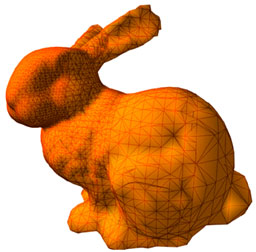 |
Convex Contouring of Volumetric Data
Ju T., Schaefer S. and Warren J.
The Visual Computer, Vol. 19, No. 7-8, 2003, pages 513-525
Abstract: In this paper we present a fast, table-driven isosurface
extraction technique on volumetric data. Unlike Marching Cubes or
other cell-based algorithms, the proposed polygonization generates
convex negative space inside individual cells, enabling fast
collision detection on the triangulated isosurface. In our
implementation, we are able to perform over 2 million point
classifications per second. The algorithm is driven by an
automatically constructed look-up table that stores compact
decision trees by sign configurations. The decision trees
determine triangulations dynamically by values at cell corners.
Using the same technique, we can perform fast, crack-free
multi-resolution contouring on nested grids of volumetric data.
The method can also be extended to extract isosurfaces on
arbitrary convex, space-filling polyhedra.
|
 |
A Factored Interpolatory Subdivision Scheme for Surfaces of Revolution
Schaefer S.
Master's Thesis, Rice University 2003 slides
Abstract: We present a new non-stationary, interpolatory subdivision scheme capable
of producing circles and surfaces of revolution and in the limit is C^1.
First, we factor the classical four point interpolatory scheme of Dyn et al.
into linear subdivision plus differencing. We then extend this
method onto surfaces by performing bilinear subdivision and a generalized
differencing pass. This extension also provides the ability to interpolate
curve networks. On open nets this simple, yet efficient, scheme reproduces
the curve rule, which allows C^0 creases by joining two patches together
that share the same boundary. Our subdivision scheme also contains a
tension parameter that changes with the level of subdivision and gives the scheme its
non-stationary property. This tension is updated using a simple recurrence
and, chosen correctly, can produce exact surfaces of revolution.
|
 |
Dual Contouring of Hermite Data
Ju T., Losasso F., Schaefer S. and Warren J.
ACM SIGGRAPH 2002, pages 339-346, slides, movie
Abstract: This paper describes a new method for contouring
a signed grid whose edges are tagged by Hermite data
(i.e; exact intersection points and normals). This method avoids the
need to explicitly identify and process "features" as
required in previous Hermite contouring methods. We extend this contouring method
to the case of multi-signed functions and demonstrate how to model
textured contours using multi-signed functions.
Using a new, numerically stable representation for quadratic error functions,
we develop an octree-based method for simplifying these contours
and their textured regions. We next extend our contouring method to these simplified octrees.
This new method imposes no constraints on the octree (such as being a restricted octree)
and requires no "crack patching". We conclude with a simple test for preserving the
topology of both the contour and its textured regions during simplification.
|
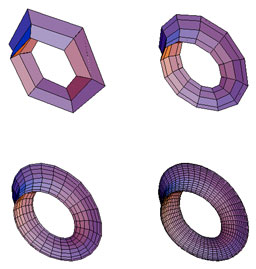 |
A Factored Interpolatory Subdivision Scheme for Quadrilateral Surfaces
Schaefer S. and Warren J.
Curves and Surface Fitting: Saint Malo 2002, pages 373-382
Abstract: This paper presents a new C^1 interpolatory subdivision scheme for quadrilateral meshes
based on the idea of factoring a complex scheme into several simpler passes. To illustrate
this point we first factor the well-known four point rule for interpolatory curve
subdivision into linear subdivision followed by a simple differencing pass. This
subdivision method is then extended to surfaces by generalizing each of these passes to
quadrilateral meshes (including those with extraordinary vertices). Finally, we
demonstrate that this extension can also be interpreted as defining a subdivision scheme
for interpolating curve networks.
|
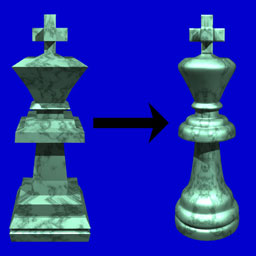 |
A subdivision scheme for hexahedral meshes
Bajaj C., Schaefer S., Warren J. and Xu G.
The Visual Computer, Vol. 18, 2002, pages 343-356
Abstract: In a landmark paper, Catmull and Clark described a simple
generalization of the subdivision rules for bi-cubic B-splines to
arbitrary quadrilateral surface meshes. This subdivision scheme has become
a mainstay of surface modeling systems. Joy and MacCracken described a
generalization of this surface scheme to volume meshes. Unfortunately,
little is known about the smoothness and regularity of this scheme due to
the complexity of the subdivision rules. This paper presents an alternative
subdivision scheme for hexahedral volume meshes that consists of a simple
split and average algorithm. Along extraordinary edges of the volume mesh,
the scheme provably converges to a smooth limit volume. At extraordinary
vertices, the authors supply strong experimental evidence that the scheme
also converges to a smooth limit volume. The scheme automatically produces
reasonable rules for non-manifold topology and can easily be extended to
incorporate boundaries and embedded creases expressed as Catmull-Clark
surfaces and B-spline curves.
|
|


 About
About Research
Research Teaching
Teaching